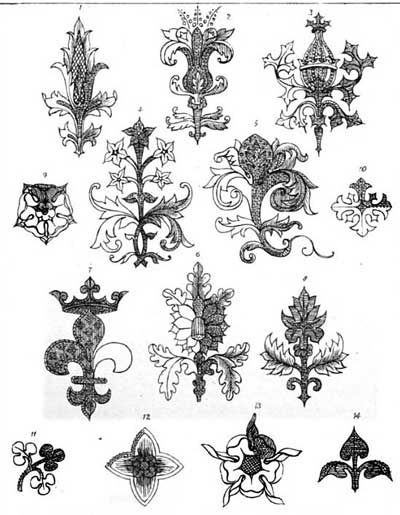This week, I came across a little old gem of a church embroidery book online. When I came upon it as a free PDF, I was delighted, so I thought I’d share it with those of you interested in church embroidery.
The name of the book is Church Embroidery, Ancient and Modern, by Anastasia Marice Dolby. Typical of older church embroidery books, while there are some black and white drawings – and some little patterns that can be elaborated upon or adapted – the book is mostly text.
In it, you’ll find instruction on older forms of church embroidery, so if you’ve ever looked at old church vestments and vesture and wondered “how they did that,” this might be a book that answers those questions.
There are also plenty of tips in the book on goldwork, embroidery on linen, applique techniques, and so forth. Of course, since the book was written quite a while ago (1867), some of the instructions are a bit dated. For example, Mrs. Dobly’s instructions on making a paste made me chuckle:
To make a needlework paste. – Paste which is sure to bind, and will never come through on the surface of the material, is shoemaker’s paste; two pennyworth of which may be had from any adjacent shoemaker.
But supposing a shoemaker be not always adjacent, we give our receipt for an excellent paste, which may be made at home.
Take 3 table-spoonfuls of flour, and as much powdered resin as will lie on a shilling; mix them smoothly with half a pint of water, pour into an iron saucepan, and stir till it boils. Let it boil 5 minutes; then turn it into a basin, and when quite cold, it is fit for use.
Since I don’t have an adjacent shoemaker, I suppose I would have to go for the home-made recipe!

Some of the little patterns in the book are nice, and would adapt well to individual motifs for goldwork or silk shading, even for secular use. I may play around with some of them to see if I can work them into clean images to use as patterns. If I do, I’ll certainly share them with you!
The book is available on Internet Archives: Church Embroidery, Ancient and Modern, by Anastasia Dolby.
I don’t know about you, but I really love these nice old needlework books that are generously being made available by those who take the time to digitize them!







Perfect timing!I was just looking for a fleur de lis…..I’ve downloaded the book,it’s a cold wet windy Saturday,so I can peruse the book without guilt!Yippee!
Ah, good – glad you find it useful! The images are somewhat small and aren’t super clear, but I think they could be traced ok. It’s a neat little book, and rather entertaining to read!
MC
Very interesting to read how these projects were accomplished in perfection.
I have read in the past that cardboard was used to create perfect sharp edges and precise shapes. Here, too, that procedure is used.
I am mostly amazed at the instructions telling us to create appliques of much of the designs and attach them with cording to be embroidered with monograms and center designs. I suppose that is how the pst needleworkers created such beautiful and perfect work.
“Nowadays” we mostly transfer onto linen the entire design and work up the whole piece at once.
Hi, Laura –
In many ecclesiastical projects, though, the ground fabric for the completed project could be a Very Large Piece – not conducive to working the whole at one time. For example, an altar frontal can be 10 feet or wider, by more than 4 feet high. Vestments are rarely worked on the whole piece of cloth, because often just the orphreys or the central medallions are embroidered. So even today, in church embroidery, it normal to work a smaller motif and attach it to the larger ground, then decorate the edge with cording to hide the edge.
I love reading the old instructions on making things like pounce or paste. I guess next time I need pounce, I’ll just grab a piece of coal from the bin!
This is great! Thanks!
-Christiana
Thanks for sharing the link! Looks interesting 🙂
Thanks a lot! This is the third on-line book I download after your suggestion 🙂 Thanks again for sharing such treasures!
je remercie
Its orsom.. i was looking for this book from many days.
i want a free embridery book
Hi Mary,
been watching your mission rose project with interest – thanks for the list of free online books; I like to study these and re-work them for statue details.
thanks a mil for sharing.
J